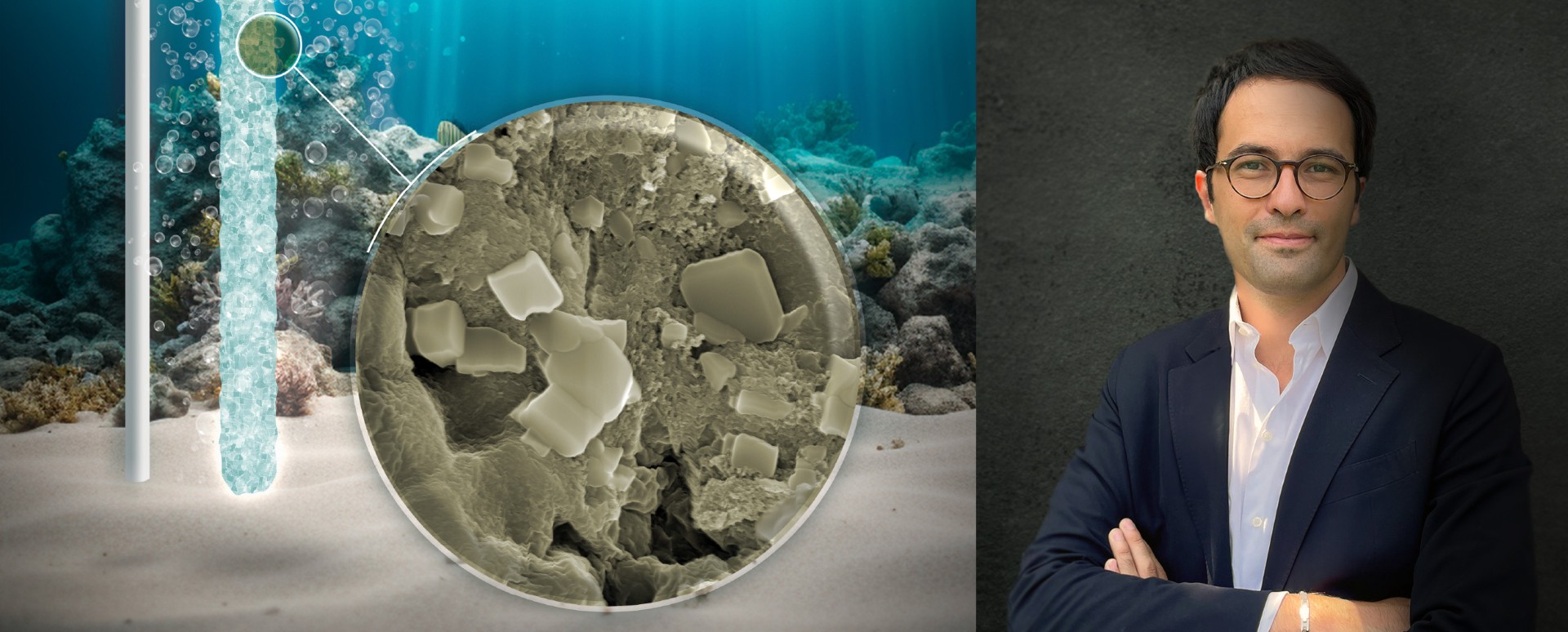Mining Seawater
Concrete’s favorable qualities and wide applications make it one of the most widely used substances in the world. The quality of concrete certainly depends on the properties of the water and cement used to manufacture it, but it is also influenced by aggregates, which occupy about 70% of any concrete volume. However, the particular quality of aggregates used to make concrete is diminishing in quantity, and mining from rivers, shorelines, and mountains is causing serious ecological issues.
Professor Alessandro Rotta Loria, along with Professor Jeffrey Lopez, postdoctoral scholar Nishu Devi, master’s student Amy Wagner, and CEMEX Vice President of Global R&D Davide Zampini and Director of Product Development and Industrialization Alexandre Guerini, has been researching a potential alternative and sustainable practice to source aggregates—one that leverages the electrodeposition of minerals from seawater.
The cover article of April’s Advanced Sustainable Systems, Vol.8(4) “Mechanistic Insights into Electrodeposition in Seawater at Variable Electrochemical Potentials” develops a mechanistic understanding of the process of electrodeposition in seawater, paving the way to utilize this novel electrically mediated approach for synthesizing aggregates from seawater.
“Essentially, [this study] envisions using seawater enclosures—akin to those used to grow fish—to sustainably grow materials that constitute, in some form, everything we have around us: from the concrete that makes up bridges, buildings, and roads to the paintings and plasters that serve as a finish and protection for the built environment,” said Alessandro Rotta Loria.
“Although we barely even think about aggregates, our lives depend on them,” he said. “We live in, travel on, communicate with, and surround ourselves with some forms or derivatives of aggregates. The results of this study indicate that we can indeed grow aggregates of tailorable structures and properties by applying mild electric stimulations to seawater. The key to this outcome is electrodeposition: an electrically mediated process capable of turning naturally dissolved substances in solutions into solid forms.”
Nishu Devi believes that this research has the potential to revolutionize the traditional construction materials industry.
Rotta Loria has been developing research about the effects of electrodeposition on civil infrastructure and geological materials since 2019, based on the rationale that increasing access to green electrons can disrupt how we handle, synthesize, and engineer substances; Devi joined in 2022.
“This paper lays the foundation for future breakthroughs in sustainable mineral production and construction material synthesis, emphasizing the importance of interdisciplinary collaboration in addressing global challenges,” she said. “It aligns with global efforts to reduce environmental impact and accelerate the transition to clean energy-produced aggregate resources.”
Despite its challenges, Devi said she enjoys that this research encourages new, interdisciplinary opportunities and applications.
“Electrodeposition offers an opportunity for sustainable mineral synthesis,” she said. “Its diverse applications such as coral reef protection and corrosion prevention for marine structures provide practical and eco-friendly solutions. Exploring this interdisciplinary project at the intersection of electrochemistry, material science, and engineering disciplines such as chemical, civil, and environmental engineering has been fascinating.”
As of today, the rate of the aggregate production process via electrodeposition from seawater is not fast enough to meet construction industry needs and has too high of a cost; however, Rotta Loria said they have “devised an approach that can overcome these limitations while embedding very significant environmental benefits.” More is forthcoming, aiming to support CEMEX in its science-based and innovation-driven endeavors to lead the building materials market with more sustainable practices.

